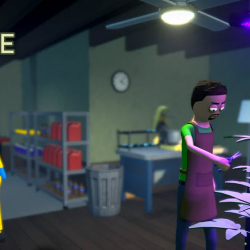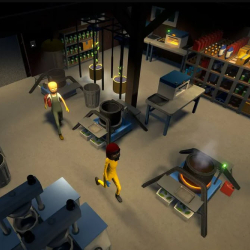
Schedule I
All trademarks belong to their respective owners.
Review
A Personal Journey into an Unconventional World
I recently had the opportunity to immerse myself in Schedule I Game, a title that boldly redefines what I expected from an interactive experience. As I powered on my console and navigated the intricacies of its initial loading screens, I found myself both surprised and delighted by the fresh sense of creativity and meticulous detail woven into every pixel. The game radiates an enchanting quality that reaches far beyond the usual conventions of its genre, and each step as I played felt like I was entering an entirely new world.
Exploration of Unique Gameplay Mechanics
The gameplay in Schedule I Game captivates you with its layered complexity and fluid mechanics. I found the controls to be responsive and the learning curve thoughtfully calibrated, urging me to explore rather than forcing rigid actions. The game’s design encourages experimentation; every decision, regardless of how small, has the potential of unlocking a hidden aspect of the world. One moment I was navigating an intricate maze of puzzles and challenges while the next I was learning about unexplored facets of the in-game physics. This balance between freedom and carefully designed constraints provided a refreshing alternative to more linear experiences I’ve encountered before.
Immersive Storytelling and Narrative Depth
What truly struck me was the narrative depth and the storytelling techniques imbedded within the game. Each chapter reveals another layer of a rich, nuanced plot that encourages introspection and critical thought. I found myself emotionally invested in the characters and their journeys. The dialogue is written with care, avoiding clichés while still building an authentic connection between myself and the challenges the characters encountered. By merging mythic themes with modern allegories, the game constantly evoked an atmosphere of wonder and suspense, making every conversation and encounter feel significant.
Stunning Aesthetics and Visual Representation
The visual design of Schedule I Game is nothing short of breathtaking. As I navigated vibrant, immersive environments, I noticed that every location is treated as a living canvas. The art style is a mix of intricate details and stylistic exaggerations that bring depth and originality to the world. Amid swirling colors and meticulous textures, every scene is carefully composed to evoke curiosity and delight. Light and shadow are masterfully employed to guide the player’s attention and spark emotions, and I particularly appreciated how the dynamic weather patterns transform the mood of the game throughout each phase of my journey.
Engaging Soundscape and Atmospheric Audio
Complementing its visual appeal, Schedule I Game boasts an audio production that is both immersive and evocative. Every note of the background score resonates with the unfolding events, accentuating the highs and lows of the experience. I was often caught off-guard by sudden shifts in the music that, instead of startling me, deepened my connection to the events I was experiencing. The sound effects, from the gentle rustling of leaves to ambient noises echoing in vast open spaces, contribute a layer of realism that makes the environment feel lived-in and dynamic. The attention to detail in the audio created a multisensory tapestry that captivated me from beginning to end.
Intuitive and Responsive User Interface
Navigating through the game’s interface was a delight in itself. Every element, whether it was a quick-access menu or a context-sensitive tutorial pop-up, was designed with the user in mind. The layout avoids clutter, and options are clear and concise, facilitating smooth transitions from one part of the game to another. I particularly appreciated how the interface adapts to various playstyles; whether I was engaging in a fast-paced mission or undertaking introspective tasks, it felt like the system was designed to follow my lead rather than impose its own agenda. The thoughtful placement of controls and the responsiveness of in-game prompts made for a seamless and highly rewarding journey.
The Dynamics of In-Game Challenges and Puzzles
One of the aspects that kept me continuously engaged was the imaginative approach to in-game challenges and puzzles. Rather than relying on repetitive tasks, the game constantly introduces novel types of problem-solving that encourage me to think creatively. I remember facing a particularly intricate challenge that required a mix of timing, spatial awareness, and strategic planning. It was refreshing to see that each puzzle felt meaningful, contributing to both my personal progression and the unfolding of the storyline. The diversity in the nature of challenges ensures that my attention never waned and made me appreciate the intellectual effort behind each design choice.
Rich Exploration and Environmental Interactivity
The game offers a vast world that is both interactive and layered with hidden details. Every nook of its expansive environments beckons with potential secrets and intriguing discoveries. As I wandered through urban sprawls juxtaposed with sprawling nature reserves, I was consistently rewarded with unique narrative cues and subtle design touches that hinted at the world’s deeper lore. I reveled in the sense of discovery that each new location provided, where elements of risk were interlaced with moments of relaxation and introspection. The purposeful design of each area meant that I was never left wondering if I had missed something, as the game encourages exploration without imposing a strict timeline or pressure to move forward hastily.
Personalization and Depth of Character Interactions
Character development is handled with extraordinary care in Schedule I Game. My interactions with various in-game personalities were far from generic; each dialogue and decision branching offered a window into their backstories, hopes, and challenges. I was particularly taken by the dynamic relationships that evolve online with the choices I made. The game does not simply present a rigid cutscene structure; instead, it provides a living conversation where my input visibly affects how characters relate to me. This significant emphasis on personalization made my in-game persona feel like an actual participant in an evolving drama rather than a static observer following a preordained script.
Innovative Craftsmanship in Side Missions
Complementing the central storyline, the side missions in Schedule I Game bring an entirely new dimension to the experience. These missions are not mere filler content; they are intricately designed challenges and narrative extensions that offer fresh perspectives on the main plot. I found that every side mission is carefully curated to enhance my overall understanding of the world, providing context and backstory to otherwise unexplained phenomena. The variety in these tasks allowed me to take breaks from the primary challenges and enjoy mini-stories that felt both rewarding and integral to the game’s broader universe. Whether I was engaging in diplomatic negotiations or managing resource-oriented tasks, each mission enriched my appreciation for the game’s overarching design.
Adaptive and Fair Challenge Scaling
Even as the game escalates in complexity, I noticed that Schedule I Game pays close attention to achieving a balance that can cater to both newcomers and seasoned players alike. The adjustment of difficulty is subtle yet effective. Early on, the challenges gently introduced me to the fundamental mechanics at a comfortable pace. Later, as I grew more proficient, the game escalated the intricacy of its puzzles and adversarial encounters, ensuring that every task felt challenging without becoming frustratingly insurmountable. I felt that my skills were continuously honed, and the satisfaction derived from overcoming each hurdle was immense. Sometimes, the challenge would be a test of reflexes, while at other moments it demanded strategic foresight, prompting me to experiment with various approaches before finding the optimal solution.
Seamless Integration of Multiplayer Elements
Beyond the engrossing single-player experience, I discovered that Schedule I Game also incorporates intriguing multiplayer elements that encourage collaboration and healthy competition. The integration of cooperative gameplay modes meant that at times, joining forces with other players was not merely an option but a rewarding adventure in itself. These shared moments allowed for rich exchanges of strategies and a mutual sense of camaraderie that transcended the solitary nature of most of the narrative. Playing with friends provided a unique layer of interaction where the unpredictability of human choices brought a fresh dynamic to the pre-scripted system. As someone who values both the solitary and community aspects of gaming, I found these features particularly enjoyable.
Technical Mastery and Fluid Performance
The technical foundation of Schedule I Game is robust and refined, a quality that did not go unnoticed during my hours of gameplay. The game runs smoothly on my system, with a stable frame rate and minimal loading times that kept me deeply engrossed in the experience. I appreciated the developers' attention to optimizing the game for a range of hardware, ensuring that even players without the latest equipment can enjoy the full breadth of its features. Every transition, from cutscenes to high-intensity action sequences, is rendered with precision and attention to detail. The result is an experience that feels both refined and resilient against technical shortcomings, allowing the story and gameplay to remain the main focus without distraction.
Exploration of Moral Ambiguities and Thought-Provoking Choices
One of the most compelling elements of Schedule I Game is the moral and ethical complexity embedded within its narrative structure. The game presents me with choices that are far from black and white; they are imbued with gray shades of responsibility, consequence, and personal reflection. Some decisions revealed facets of my personality that I had never considered before, forcing me to weigh the implications not only on my character but on the broader narrative landscape. The in-game consequences are both subtle and profound, making each decision feel impactful and layered with significance. I found myself pondering long after each session about the nature of right and wrong, and that reflective quality made each playthrough a personal journey in philosophical exploration.
Engaging World-Building and Environmental Storytelling
Perhaps one of the most enchanting aspects of Schedule I Game is the world-building. Every environment is meticulously crafted to tell its own story without uttering a single word. A dilapidated building in a deserted urban landscape, for instance, speaks volumes about the history and suffering of its inhabitants. I marveled at how much narrative depth was conveyed solely through environmental cues—weathered architecture, scattered relics, and subtle hints in the backdrop all contributed to a sense of wonder and speculation. The game masterfully blurs the distinction between the living, breathing world and the structured narrative, creating an experience where the environment effectively becomes an active, dynamic character within the story.
Dynamic Interaction with the Game Universe
In Schedule I Game, every interaction is deliberate and layered with multiple meanings. Whether I was resolving a challenging puzzle, initiating dialogue with a complex character, or navigating unexpected environmental hazards, the game rewarded my curiosity and adaptability. I felt as if the entire universe was responsive, actively engaging with my every choice and move. This level of dynamic interaction made the gameplay feel organic and deeply personal — as if the game was tailored specifically for me. The blend of pre-designed narrative beats with emergent situational responses provided a harmonious fusion of design that kept me perpetually on my toes, eager to uncover the next secret or unravel a new mystery.







Leave a comment
Your comment is awaiting moderation. We save your draft here
0 Comments